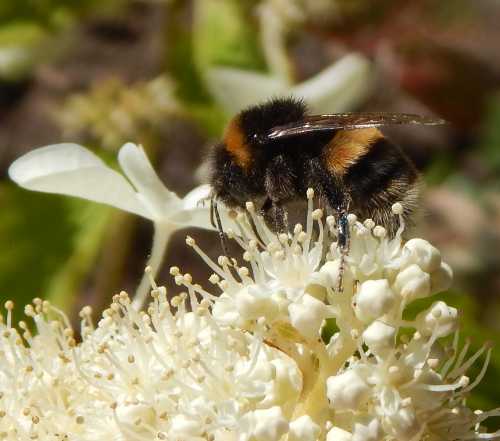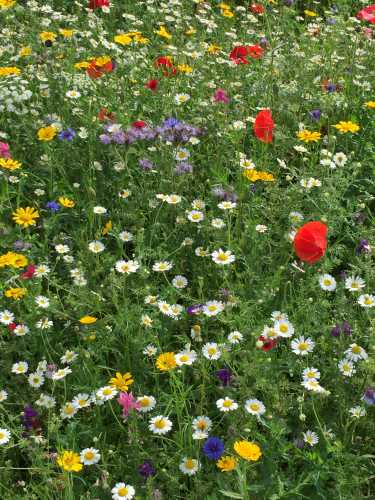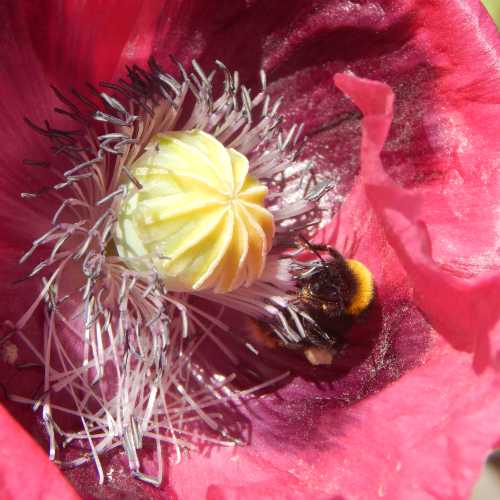Attracting Bees
A garden without the buzz, scurry, flutter, or song of wildlife, is in my view, seriously incomplete.
There is a lot of information on this site, and I hope
you'll enjoy taking a look at the resources.
Attracting Bees
Here are my suggestions to help you to encourage bees to visit and thrive in your garden.
The Vegetable Garden
You may be specifically interested in how to attract bees to your fruit and vegetables because you are keen to increase the chances of pollination and hence abundance of crop.
If this is the case, it's a good idea to include flowers among the sowing. Some flowers will encourage beneficial pollinators as well as helpful 'pest' predators, such as hoverflies.
- On our allotment, I grow sweet peas among the runner beans.
- Nasturtiums are great when allowed to ramble in a border close to the corgettes, without competing with them.
- I also recommend phacelia below flowering fruits (check the flowering times of each).
- Always keep a few pots of flowering favourites, such as linaria and lamb's ear. Bees love these, and the pots can be moved around the garden and into target zones, where pollination is important.
- Allow some of your crops to flower if you can spare it, such as kale - the seeds of kale are also edible, so you can collect them afterwards.
 A couple of kale plants were left to flower in our allotment - they were covered in grateful pollinators!
A couple of kale plants were left to flower in our allotment - they were covered in grateful pollinators!
Provide A Place to Nest
- It is easy to provide a home for solitary bees, simply by tying a bundle of hollow garden canes together between 20 – 30 cm long, and hanging them in a sheltered spot. I have experimented with different lengths of canes as well as shop-bought bug houses - and all have been successful!
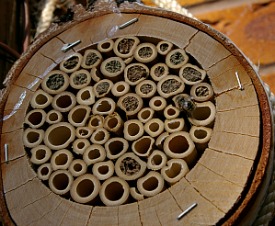
Watch mason bees using this bee house.
- Bumble bees can be more fussy. There is further information on my page about
Bumble bee Nests.
Shop-bought bumble bee nest boxes have provided mixed results, with some being successful, whilst others have not, despite the expense. However, you could experiment with an upturned plant pot beneath the garden shed (supply some dried, chemical-free grass or hamster bedding), or even an old tea pot. You may also have success with a traditional bird nest box - if it is not inhabited by birds, of course! Please do not 'kidnap' a bumble bee in order to encourage it to nest in your bee house - the conditions may not be suitable for the species and it may already have found a suitable site elsewhere. - I do not recommend that you buy boxes of bumble bees for your garden,
even if they are native, simply because they may transmit diseases to wild bees.
- Attracting honey bees depends mostly on whether there are
beekeepers nearby. It
is possible you could attract a swarm, which you may or may not be happy about! Honey bees naturally nest in
the hollows of trunks or in caves. T
Plant The Right Plants!
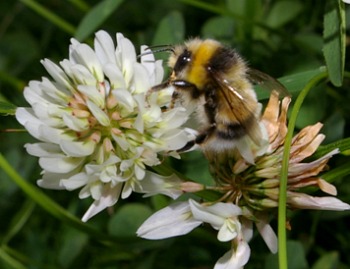
- Flower structures, in terms of the arrangement and shapes of petals and flower heads are a consideration, but one that is easy to miss. To find out more, see this feature about flower borders for bees.
- Don't be afraid to have several patches of the same plant type around your garden. Varying levels of light can help to extend the season - I have noticed this in my experiments with Lamb's Ear which I planted to attract wool carder bees.
Successional sowing is also a good idea, as well as planting in patches or in swathes. - Fortunately, whatever your growing conditions, there are plants you can include that will help encourage a visit from bees and other pollinators - see Gardening For Bees In Problem Places.
- Many lovely wildflowers are great for attracting bees and other
wildlife. They can also greatly extend our choices for filling
difficult spaces with plants that are often very cost effective to buy -
or even free! See wildflowers for bees.
- Note that some bees will nest in lawns (causing no damage to the lawn itself), so why not decide to be relaxed about your lawn, and avoid using chemicals. Take a look at my page about lawns for bees, where there is lots of advice about how to make your lawn more bee-friendly.
- For several comprehensive lists of
plants, flowers, shrubs, fruit & veg, wildflowers, trees, lawns and
plants for problem places, visit my link about
Bee Plants. (opens new window).
Attracting Bees To Small Gardens
Bees don't see gardens as separate land entities. Your garden is part of a larger landscape from which bees and pollinators can search for food.
This means seeing your garden as part of the whole, and adding to the (hopefully many!) possible feeding stations for bees in your local area.
Even if you only have concrete or a balcony, consider pots and hanging baskets, and even window boxes. These can be filled with a range of trailing plants, herbs, and bedding flowers attractive to bees and pollinators, such as low growing bedding campanula, beach aster and hardy geraniums. Imagine if the residents of a high rise apartment block featured hanging baskets filled with nectar and pollen rich plants - we'd have pollinator walls!
Read more tips about gardening for bees in small spaces.
Supply Water
Water
is helpful not just to bees, but also a range of wildlife. A small
wildlife pond with a shallow area would be ideal, but failing that, a
simple bird bath or tray of water with a few stones (to create shallow
zones) can help.
So you see, attracting bees into
your garden need not be difficult, and there are possibilities even in
problem zones and limited spaces. We simply need to make more of an
effort to consider the bees and other wildlife, as we plan our gardens.
If you found this page helpful or interesting, I'd really be grateful if you would share it with others - if not this page, perhaps another, such as Gardening For Bees.
Thank you so much :) .
